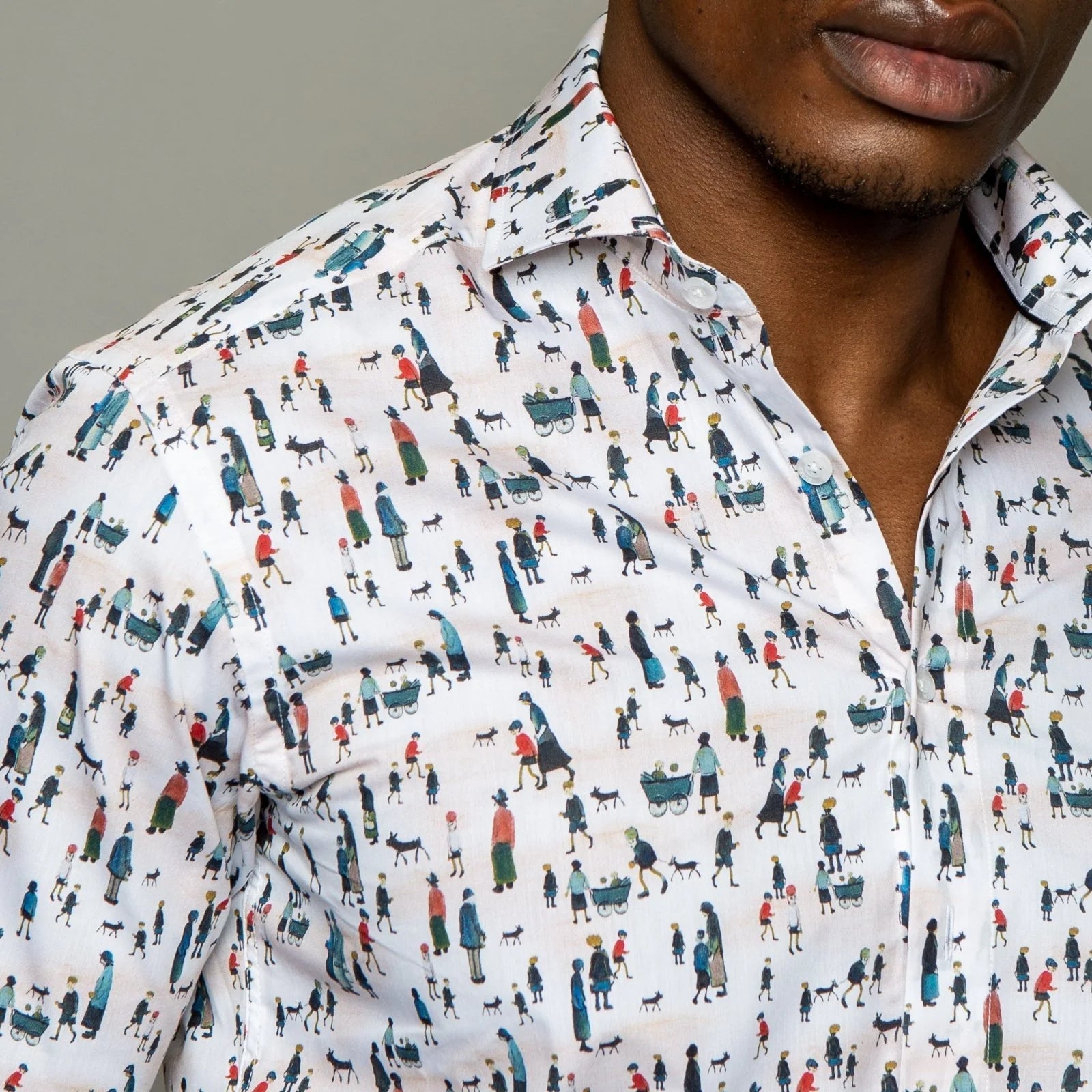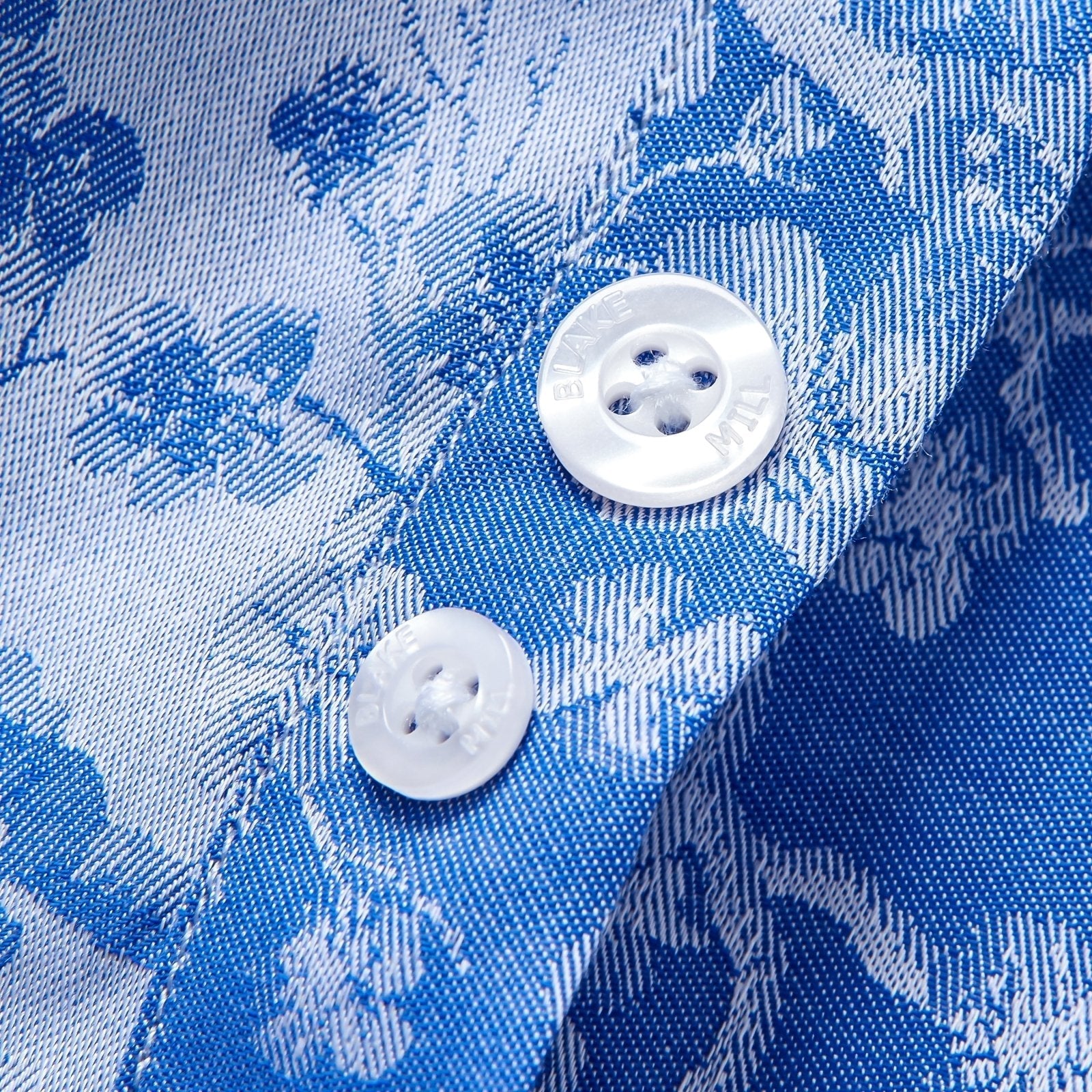The Art of Measuring Men's Shirt Sizes: The Perfect Fit
Understanding Men's Shirt Sizes
Men's shirt sizes can be puzzling, but fret not! Understanding the nuances is key to achieving that perfect fit. From collar sizes to sleeve lengths, each measurement plays a vital role. Dive into the intricacies of men's shirt sizes to unlock the secrets of a well-fitting wardrobe. So, grab your measuring tape and get ready to decode the language of shirt sizes with flair!
The Importance of the Right Fit
The right fit is crucial when it comes to men's shirts for several reasons. First and foremost, a perfect fit enhances your personal style and makes you look well put-together. When a shirt fits well, it creates a polished and sophisticated appearance that exudes confidence.
Wearing a shirt that is too tight or too loose can be uncomfortable and restrict your movement. A good fit allows for ease of movement and ensures that you can carry out your daily activities comfortably. Whether you're at work, attending a formal event, or simply going about your day, a shirt that fits well will make you feel more at ease and confident.
Additionally, a well-fitted shirt can also enhance your overall appearance. It can make you appear taller, slimmer, and more proportionate. On the other hand, an ill-fitting shirt can make you look sloppy and unkempt.
Overall, the right fit is essential for both comfort and style. Investing in tailored mens shirts or shirts that fit properly and paying attention to measurements will ensure that you always look your best.
Common Misconceptions About Shirt Sizing
When it comes to shirt sizing, there are some common misconceptions that can lead to confusion. One misconception is that the second number in shirt sizing represents the sleeve length. In reality, the second number indicates the length of the shirt itself, not the sleeve length. The sleeve length can vary depending on the style and cut of the shirt.
Another misconception is that dress shirts are sized differently than regular shirts. While dress shirts often have specific measurements, such as neck size and sleeve length, regular shirts typically come in small, medium, large, and extra-large sizes. It's important to pay attention to the sizing charts provided by the brand to ensure the right fit.
It's also important to note that sleeve length can vary depending on the style and cut of the shirt. Some shirts may have longer sleeves to accommodate a specific style, while others may have shorter sleeves for a more casual look. It's always recommended to try on different styles and sizes to find the one that fits your body shape and personal style the best.

Essential Measurements for the Perfect Shirt Fit
To achieve the perfect fit in a men's shirt, there are a few essential measurements that you need to take into consideration. These measurements include neck size, sleeve length, chest measurement, and waist measurement. By taking accurate measurements, you can ensure that the shirt fits comfortably and flatters your body shape. These measurements can also help you determine the correct size when shopping for shirts online or in stores.
How to Measure Your Neck Size
Measuring your neck size is an essential step in finding the perfect fit for a men's shirt. To measure your neck size, you will need a flexible measuring tape. Start by wrapping the measuring tape around the base of your neck, where the collar of the shirt would sit. Make sure the tape is snug but not too tight. Take note of the measurement in inches.
When it comes to choosing the right collar size, it's important to leave a little extra room for comfort. You don't want the collar to be too tight and constricting. However, it shouldn't be so loose that it slides off easily. Finding the right balance will ensure a comfortable fit that looks polished and professional.
When shopping for shirts, pay attention to the collar size indicated on the label. Different brands may have slightly different sizing, so it's always a good idea to try on different sizes to find the one that fits your neck comfortably.
Determining Your Sleeve Length
Determining your sleeve length is crucial for achieving the perfect fit in a men's shirt. To measure your sleeve length, follow these steps:
- Start by standing up straight with your arms relaxed at your sides.
- Ask someone to help you with the measurement or use a mirror to assist you.
- Measure from the shoulder seam, where the shoulder meets the sleeve, down to the end of the cuff.
- Take note of the measurement in inches.
When measuring your sleeve length, it's important to consider the following factors:
- The length of the shirt sleeve should end right at the break of your wrist.
- When wearing a suit jacket or blazer, about ½" of shirt cuff should be visible below the suit jacket cuff when standing in a natural stance with your arms relaxed by your side.
- When holding a phone to your ear, raising a wine glass, or giving a presentation in the boardroom, it is normal for your jacket sleeves to ride up a little, showing more shirt cuffs.
By following these guidelines, you can ensure that your shirt sleeves are the perfect length, allowing for ease of movement and a polished appearance.
Chest and Waist Measurements for a Comfortable Fit
In addition to neck size and sleeve length, chest and waist measurements are important for achieving a comfortable fit in a men's shirt. Here are a few tips for measuring your chest and waist:
- Chest Measurement: To measure your chest, wrap the measuring tape around the fullest part of your chest, just under your armpits. Make sure the tape is snug but not too tight. Take note of the measurement in inches.
- Waist Measurement: To measure your waist, wrap the measuring tape around your natural waistline, which is typically above your belly button. Again, make sure the tape is snug but not too tight. Take note of the measurement in inches.
By taking accurate chest and waist measurements, you can ensure that the shirt fits comfortably and provides enough room for movement. This is especially important if you prefer a more fitted or tailored look.
Tools You Need for Accurate Measurements
To take accurate measurements for a men's shirt, there are a few essential tools that you will need:
- Measuring Tape: A flexible measuring tape is essential for measuring neck size, sleeve length, chest measurement, and waist measurement. It allows for precise measurements and ensures a proper fit.
- Tailor's Tape Measure: A tailor's tape measure is specifically designed for measuring garments and provides accurate measurements. It is more flexible and easier to handle than a regular measuring tape.
By using these tools, you can ensure that your measurements are accurate and achieve the perfect fit in a men's shirt.
The Tailor's Tape Measure: An Essential Tool
When it comes to taking accurate measurements for a men's shirt, a tailor's tape measure is an essential tool. Unlike a regular measuring tape, a tailor's tape measure is specifically designed for measuring garments and provides precise measurements.
A tailor's tape measure is typically made of flexible material, such as fabric or vinyl, that allows for easy handling and accurate readings. It also includes both inches and centimetres for measuring purposes.
The flexibility of a tailor's tape measure allows you to easily wrap it around different parts of your body, such as the neck, chest, waist, and sleeve, to take accurate measurements. It also ensures that the tape stays in place without slipping or sliding, providing consistent measurements.
Whether you're measuring your neck size, sleeve length, chest measurement, or waist measurement, a tailor's tape measure is an indispensable tool for achieving the perfect fit in a men's shirt.
Using a Ruler for Quick Checks
While a tailor's tape measure is the ideal tool for taking precise measurements, a ruler can also come in handy for quick checks when it comes to men's shirt sizing. A ruler provides a straight line for measuring purposes and can be used to double-check measurements or make quick adjustments.
When using a ruler for shirt measurements, it's important to keep the following tips in mind:
- Use a ruler with both inches and centimetres for versatility.
- Ensure that the ruler is straight and not bent or curved.
- Hold the ruler firmly against the area you're measuring to prevent any movement or shifting.
A ruler can be particularly useful when checking the length of a shirt sleeve or the width of a collar. It allows for a quick assessment of the fit and provides a visual reference for any necessary adjustments.
Step-by-Step Guide to Measuring Your Shirt Size
To determine your shirt size and achieve the perfect fit, follow these step-by-step instructions:
- Measure your neck size by wrapping a measuring tape around the base of your neck.
- Measure your sleeve length by measuring from the shoulder seam to the end of the cuff.
- Measure your chest by wrapping the measuring tape around the fullest part of your chest.
- Measure your waist by wrapping the measuring tape around your natural waistline.
By taking accurate measurements and referring to sizing charts provided by brands, you can find the right shirt size that fits your body shape and personal style.
Measuring the Neck for Collar Fit
Measuring the neck is an important step in determining the collar size for a men's shirt. To measure your neck size, follow these steps:
- Wrap a flexible measuring tape around the base of your neck, where the collar of the shirt would sit.
- Make sure the tape is snug but not too tight, allowing for comfort and ease of movement.
- Take note of the measurement in inches.
When choosing the right collar size, it's important to leave a little extra room for comfort. You don't want the collar to be too tight and constricting. However, it shouldn't be so loose that it slides off easily.
Different brands may have slightly different sizing, so it's always a good idea to try on different sizes to find the one that fits your neck comfortably. A well-fitted collar enhances the overall appearance of the shirt and ensures a polished and professional look.
Sleeve Length: From Shoulder to Wrist
The sleeve length is an important measurement to consider when finding the perfect fit for a men's shirt. To measure your sleeve length, follow these steps:
- Stand up straight with your arms relaxed at your sides.
- Measure from the shoulder seam, where the shoulder meets the sleeve, down to the end of the cuff.
- Take note of the measurement in inches.
When determining the ideal sleeve length, keep the following factors in mind:
- The length of the shirt sleeve should end right at the break of your wrist.
- When wearing a suit jacket or blazer, about ½" of shirt cuff should be visible below the suit jacket cuff when standing in a natural stance with your arms relaxed by your side.
- When holding a phone to your ear, raising a wine glass, or giving a presentation in the boardroom, it is normal for your jacket sleeves to ride up a little, showing more shirt cuffs.
By following these guidelines, you can ensure that your shirt sleeves are the perfect length, allowing for ease of movement and a polished appearance.
Chest Measurement: Ensuring Adequate Room
The chest measurement is an important consideration when finding the perfect fit for a men's shirt. To measure your chest, follow these steps:
- Wrap a measuring tape around the fullest part of your chest, just under your armpits.
- Make sure the tape is snug but not too tight, allowing for comfort and ease of movement.
- Take note of the measurement in inches.
The chest measurement determines the width of the shirt and ensures adequate room for a comfortable fit. It's important to consider your body shape and personal style when choosing the right chest measurement.
A shirt that is too tight in the chest can restrict your movement and feel uncomfortable. On the other hand, a shirt that is too loose may look baggy and unflattering. Finding the right balance will ensure that the shirt fits comfortably and enhances your overall appearance.
Interpreting Shirt Size Charts
Shirt size charts provide valuable information when it comes to choosing the right size for a men's shirt. By understanding how to read these charts correctly, you can ensure a proper fit. Shirt size charts typically include measurements for neck size, sleeve length, chest, and waist.
When using a shirt size chart, it's important to refer to your own measurements and choose the size that aligns with those measurements. Different brands may have slight variations in sizing, so it's always recommended to try on different sizes to find the one that fits your body shape and personal style the best.
How to Read Size Charts Correctly
Reading shirt size charts correctly is essential for finding the right fit in a men's shirt. Here are a few tips to ensure that you interpret size charts accurately:
- Refer to your own measurements: Take accurate measurements of your neck size, sleeve length, chest, and waist and compare them to the measurements provided on the size chart.
- Consider the brand's sizing: Different brands may have slight variations in sizing, so it's important to refer to the specific brand's size chart. Pay attention to any sizing notes or recommendations provided by the brand.
- Take into account your body type: Consider your body shape and personal style when choosing the right size. A size that fits well on one person may not fit the same way on another person with a different body type.
By following these guidelines, you can ensure that you accurately interpret size charts and find the right size for a men's shirt that fits your body shape and personal style.
Comparing International Sizing Standards
International sizing standards can vary, which can make it challenging to find the right size for a men's shirt. To help you navigate these differences, here is a comparison of the sizing standards for the UK, US, and EU:
|
UK Size |
US Size |
EU Size |
|
14 |
14 ½ |
37 |
|
14 ½ |
15 |
38 |
|
15 |
15 ½ |
39 |
|
15 ½ |
16 |
41 |
|
16 |
16 ½ |
42 |
It's important to note that these sizing standards may vary slightly between brands, so it's always a good idea to refer to the specific brand's size chart for accurate measurements. Additionally, keep in mind that different countries may have their own unique sizing standards, so it's important to consider the specific country's sizing when shopping for shirts internationally.
By comparing international sizing standards and referring to brand-specific size charts, you can ensure that you find the right size for a men's shirt that fits your body shape and personal style.
Frequently Asked Questions
What if My Measurements Fall Between Sizes?
If your measurements fall between sizes, it's recommended to choose the larger size and have the shirt altered for a more precise fit. Taking the shirt to a tailor can ensure that it fits your body perfectly and enhances your personal style.
How Often Should I Re-measure Myself?
It's recommended to re-measure yourself every time you shop for new shirts or whenever there are changes in your body size or shape. Regularly re-measuring yourself will ensure that you always choose the right size and achieve the perfect fit.
Can I Alter a Shirt for a Better Fit?
Yes, it is possible to alter a shirt for a better fit. Taking the shirt to a tailor can help make adjustments to the collar, sleeve length, chest, and waist to ensure a customised and comfortable fit. Alterations can help achieve a more flattering and polished look.
In conclusion, mastering men's shirt sizes and achieving the perfect fit is essential for both comfort and style. Understanding the different sizes and measurements, such as neck size, sleeve length, chest, and waist, can help you find the right size that flatters your body shape and personal style. By taking accurate measurements, referring to size charts, and considering international sizing standards, you can ensure a comfortable and polished fit in men's shirts. Additionally, alterations can be made to customise the fit of a shirt for a more precise and flattering look. Remember to re-measure yourself regularly and consult with a tailor for any necessary adjustments. With the right fit, you can confidently rock a perfectly tailored shirt that enhances your personal style.
'We're living in a material world', said some pop star or other! So, with that, check out our next guide, Exploring the World of Shirt Weaves.






